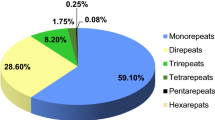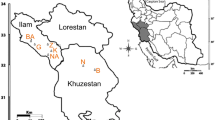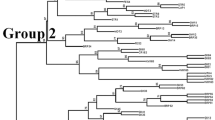Abstract
The first set of simple sequence repeat (SSR) markers for Urochloa mosambicensis (Hack.) Dandy is described in this study. SSRs were isolated from a genomic library with 3491 contigs obtained by high-throughput sequencing. Primers were designed for twenty loci, and all primer pairs were successfully amplified in 39 genotypes, yielding an average of 4.95 alleles per locus. The mean polymorphic information content (PIC) was 0.559, and the mean discriminating power (DP) was 0.520 for all loci considering also all U. mosambicensis genotypes. The non‐Bayesian clustering analysis has confirmed clustering consistency of the individuals and provides enough support for the existence of the pattern that also emerged from PCoA and UPGMA. These markers demonstrated potential transferability to U. advena, U. oligotricha, U. brachyura and U. xantholeuca. Our findings showed that the set of molecular markers described here have strong potential for fingerprinting and characterizing genetic diversity in intra-specific plant collections, whose breeding programs could be accelerated by the effective use of these molecular tools, not only in U. mosambicensis, but also within the genus Urochloa.

Similar content being viewed by others
Data availability
The datasets generated or analyzed during the current study are available in the GenBank repository (accession numbers MH742936–MH742955) but restrictions apply to the availability of these data, so they are not publicly available until article publication.
References
Abd El-Moghny AM, Santosh HB, Raghavendra KP, Sheeba JA, Singh SB, Kranthi KR (2017) Microsatellite marker based genetic diversity analysis among cotton (Gossypium hirsutum) accessions differing for their response to drought stress. J Plant Biochem Biotechnol 26(3):366–370
Abdelkrim J, Robersten BC, Stanton JA, Gemmell NJ (2009) Fast, cost-effective development of species-specific microsatellite markers by genome sequencing. Biotechniques 46:185–191
Bernatchez L, Duchesne P (2000) Individual-based genotype analysis in studies of parentage and population assignment; how many loci, how many alleles? Can J Fish Aquat Sci 57(1):1–12
Botstein D, White RL, Skolnick M (1980) Construction of a genetic linkage map in man using restriction fragment length polymorphisms. Am J Med Genet 32:314–331
Bueno LG, Alves MMA, Rocha JES, Cavalcante ACR, Galvani DB, Diniz FM, Valle CB, Cândido MJD (2019). Caracterização morfogênica de Urochloa mosambicensis para seleção de genótipos elite em programa de melhoramento de forrageiras. Boletim de Pesquisa e Desenvolvimento/Embrapa Caprinos e Ovinos 11, Sobral: Embrapa Caprinos e Ovinos, 2019. 19 p.
Bueno LG, Galvani DB, Voltolini TV, Diniz FM (2022) Capim-urocloa, alternativa para região semiárida. In: Santos MVF, Neiva JNM (Org.). Culturas forrageiras no Brasil: uso e perspectivas. Visconde do Rio Branco: Suprema Gráfica, p. 177–197.
Chen X, Cho Y, McCouch S (2002) Sequence divergence of rice microsatellites in Oryza and other plant species. Mol Genet Genomics 268(3):331–343
Duchesne P, Turgeon J (2012) FLOCK provides reliable solutions to the “number of populations” problem. J Hered 103:734–743
Engel SR, Linn RA, Taylor JF, Davis SK (1996) Conservation of microsatellite loci across species of Artiodactyls: Implications for population studies. J Mammalog 77(2):504–518
Faircloth B (2008) Msatcommander: Detection of microsatellite repeat arrays and automated, locus-specific primer design. Mol Ecol Resour 8:92–94
Ferreira RCU, Cançado LJ, Valle CB, Chiari L, Souza AP (2016) Microsatellite loci for Urochloa decumbens (Stapf) RD Webster and cross-amplification in other Urochloa species. BMC Res Notes 9:152
Jank L, Resende RMS, Valle CB (2005) Genética Em Pastagens. Rev USP 64:86–93
Jombart T (2008) adegenet: a R package for the multivariate analysis of genetic markers. Bioinformatics 24(11):1403–1405
Jungmann L, Sousa ACB, Paiva J, Francisco PM, Vigna BBZ, Valle CB, Zucchi MI, Souza AP (2009) Isolation and characterization of microsatellite markers for Brachiaria brizantha (Hochst. ex A. Rich.) Stap. Conserv Genet 10:1873
Jungmann L, Vigna BBZ, Paiva J, Sousa ACB, Valle CB, Laborda PR, Zucchi MI, Souza AP (2009b) Development of microsatellite markers for Brachiaria humidicola (Rendle) Schweick. Conserv Genet Resour 1:475
Kamvar ZN, Tabima JF, Grünwald NJ (2014) Poppr: an R package for genetic analysis of populations with clonal, partially clonal, and/or sexual reproduction. PeerJ 2:e281
Kuwi SO, Kyalo M, Mutai CK, Mwilawa A, Hanson J, Djikeng A, Ghimire SR (2018) Genetic diversity and population structure of Urochloa grass accessions from Tanzania using simple sequence repeat (SSR) markers. Rev Bras Bot 41:699–709
McIvor JG (1992) Urochloa mosambicensis (Hack.) Dandy. In ‘Plant Resources of South-East Asia No 4. Forages’ (Eds L Mannetje and RM Jones) pp. 230–231. (Pudoc Scientific Publishers, Wageningen, The Netherlands).
Morrone O, Zuloaga FO (1992) Revision de las especies sudamericanas nativas e introducidas de los generos Brachiaria y Urochloa (Poacaeae:Panicoideae:Paniceae). Darwiniana 31(1–4):43–109
Nadeem MA, Nawaz MA, Shahid MQ, Doğan Y, Comertpay G, Yıldız M, Hatipoğlu R, Ahmad F, Alsaleh A, Labhane N, Özkan H, Chung G, Baloch FS (2018) DNA molecular markers in plant breeding: current status and recent advancements in genomic selection and genome editing. Biotechnol Biotechnol Equip 32(2):261–285
Nazareno AG, Reis MS (2011) The same but different: monomorphic microsatellite markers as a new tool for genetic analysis. Am J Bot 98(10):e265–e267
Ondabu N, Maina S, Kimani W, Njarui D, Djikeng A, Ghimire S (2017) Molecular characterizations of Kenyan Brachiaria grass ecotypes with microsatellite (SSR) markers. Agronomy 7(1):8
Paradis E, Claude J, Strimmer K (2004) APE: analyses of phylogenetics and evolution in R language. Bioinformatics 20:289–290
Peakall R, Smouse PE (2012) GenAlEx 65: Genetic analysis in Excel population genetic software for teaching and research: an update. Bioinformatics 28:2537–2539
Primmer CR, Merilä J (2000) A low rate of cross-species microsatellite amplification success in Ranid frogs. Cons Gen 3:445–449
Rakshit A, Rakshit S, Singh J, Chopra SK, Balyan HS, Gupta PK, Bahat SR (2010) Association of AFLP and SSR markers with agronomic and fibre quality traits in Gossypium hirsutum L. J Genet 89(2):155–162
Santos JCS, Barreto MA, Oliveira FA, Vigna BBZ, Souza AP (2015) Microsatellite markers for Urochloa humidicola (Poaceae) and their transferability to other Urochloa species. BMC Res Notes 8:83
Serrote CML, Reiniger LRS, Silva KB, Rabaiolli SMDS, Stefanel CM (2020) Determining the Polymorphism Information Content of a molecular marker. Gene 726:144175
Silva PIT, Martins AM, Gouvea EG, Pessoa-Filho M, Ferreira ME (2013) Development and validation of microsatellite markers for Brachiaria ruziziensis obtained by partial genome assembly of Illumina single-end reads. BMC Genom 14:17
Simpson MC (2012) Microsatellite analysis of Ceratocystis fimbriata. Dissertation (M.Sc.), University of Pretoria, Pretoria, South Africa.
Tessier C, David J, This P, Boursiquot JM, Charrier A (1999) Optimization of the choice of molecular markers for varietal identification in Vitis vinifera L. Theor Appl Genet 98:171–177
Torres-González AM, Morton CM (2005) Molecular and morphological phylogenetic analysis of Brachiaria and Urochloa (Poaceae). Mol Phylogenet Evol 37:36–44
Valle CB, Jank L, Resende RMS (2009) O melhoramento de forrageiras tropicais no Brasil. Rev Ceres 56(4):460–472
Vigna BBZ, Alleoni GC, Jungmann L, Valle CB, Souza AP (2011a) New microsatellite markers developed from Urochloa humidicola (Poaceae) and cross amplification in different Urochloa species. BMC Res Notes 4:523
Vigna BBZ, Jungmann L, Francisco PM, Zucchi MI, Valle CB, Souza AP (2011b) Genetic diversity and population structure of the Brachiaria brizantha germplasm. Trop Plant Biol 4:157–169
Acknowledgements
The authors would like to thank the Genomics and Bioinformatics Center of Drug Research and Development Center of Federal University of Ceará for technical support.
Funding
The Brazilian Agricultural Research Corporation–Embrapa and The Foundation for Scientific and Technological Development of Ceará–FUNCAP funded this study through the project grant no. MP 22.16.04.018.00 (MegFor) and BP5-0197-00214.01.00/22, respectively. FMD would like to thank FUNCAP for a Research Productivity Scholarship.
Author information
Authors and Affiliations
Contributions
USL, LGB, DBG, ABN, and GRS were involved in sample collection, methodology, laboratory work, data curation, formal analysis, manuscript writing. FBB and JLRS contributed to data curation, manuscript reviewing and editing. LGB, DBG, RM and FMD carried out fieldwork, partial funding acquisition and manuscript reviewing. USL and FMD supported laboratory work, LGB and DBG contributed to conceptualization, fieldwork, methodology, resources, supervision, writing original draft and editing. All authors read and approved the final manuscript.
Corresponding author
Ethics declarations
Conflict of interest
The authors declare no conflict of interest.
Additional information
Publisher's Note
Springer Nature remains neutral with regard to jurisdictional claims in published maps and institutional affiliations.
Supplementary Information
Below is the link to the electronic supplementary material.
Rights and permissions
Springer Nature or its licensor (e.g. a society or other partner) holds exclusive rights to this article under a publishing agreement with the author(s) or other rightsholder(s); author self-archiving of the accepted manuscript version of this article is solely governed by the terms of such publishing agreement and applicable law.
About this article
Cite this article
Leão, U.S., Bueno, L.G., Negreiros, A.B. et al. Unveiling the demographic background and genetic diversity of Urochloa mosambicensis (Poaceae) through genome-wide identification of simple sequence repeats and molecular marker development. Conservation Genet Resour 15, 135–143 (2023). https://doi.org/10.1007/s12686-023-01312-8
Received:
Accepted:
Published:
Issue Date:
DOI: https://doi.org/10.1007/s12686-023-01312-8




